by Tom Gaylord
Writing as B.B. Pelletier

Daisy Number 12 model 29 single shot BB gun.
This report covers:
- The gun
- Hough front sight
- Loading
- The BB changed from lead to steel
- Getting 0.175-inch lead shot
- Darts, too!
- Summary
Sometimes we like things for reasons that make no sense to others, though we know why. Today’s report focuses on a BB gun that I have liked for many years, after discovering late in life that it existed at all.
The gun
Daisy’s Number 12 Model 29 is a lever action BB gun with a difference. It looks older than it is. It resembles a Daisy model H that was made from 1913 to 1923. The strangest thing about the model H is the cocking lever, which catches your eye immediately. In many respects these guns look similar to the more common BB guns we know today, but that cocking lever seems strange. I have not read an explanation for why it looks like it does, so allow me to posit a guess — leverage.
BB guns of this era have powerful mainsprings compared to the guns of today, and they are much harder to cock. I am guessing the designers at Daisy decided to do something about it. Most adults will not be able to get all 4 of their fingers through the smaller loop, but when you put the first three through, your thumb then pushes against the straight section ahead of the loop, making the lever much easier to cock. I may be completely wrong about the reason for the design, but that’s the way it works.
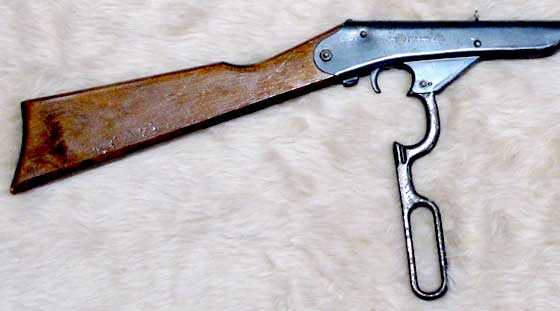
This is as far as the cocking lever moves when the gun is cocked.
In 1924 the H model morphed into the numbers 11 (350-shot repeater) and 12 (single shot) model 24. And, in 1929, the model 29 replaced the model 24, in both numbers 11 (repeater) and 12 (single shot). The gun we are looking at is the number 12 single shot.
This model 29 was made from 1929 until 1942, when Daisy stopped making all BB guns to make war materiel. After the war this model was not resumed — probably because it shot a BB that was growing increasingly obsolete.
Hough front sight
This gun has a barrel that quickly removes so a dart can be loaded in its breech. To take the barrel out the front sight is spring-loaded in a bayonet notch. Push back the sight and rotate slightly and the tube comes free. Edward C. Hough patented this feature in 1908, and for some reason his name has been associated with it ever since.
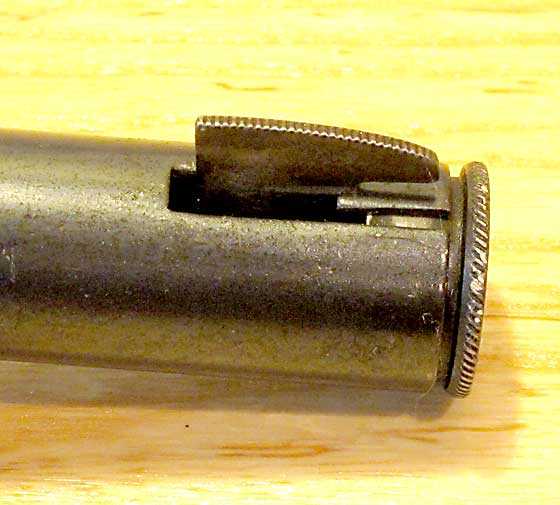
The Hough front sight is spring-loaded to keep the shot tube in the gun. Push it back and rotate to release the tube.
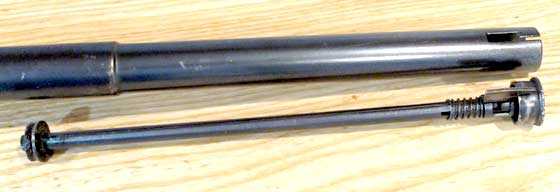
Shot tube removed.
Loading
How was a single shot BB gun loaded? At the risk of not being politically correct, let me tell you that little boys with single shot BB guns went around with several BB shot in their mouth! That’s right — lead BB shot, or Air Rifle Shot, to use the correct title. When it came time to load their guns they expertly spit a single BB down the muzzle. Mothers of America unite! I can see a whole career of gun safety lectures, right here!
The muzzle of single shot guns was often shaped like a funnel, to help with the loading process. This continues today on Daisy’s 499 Champion BB gun.
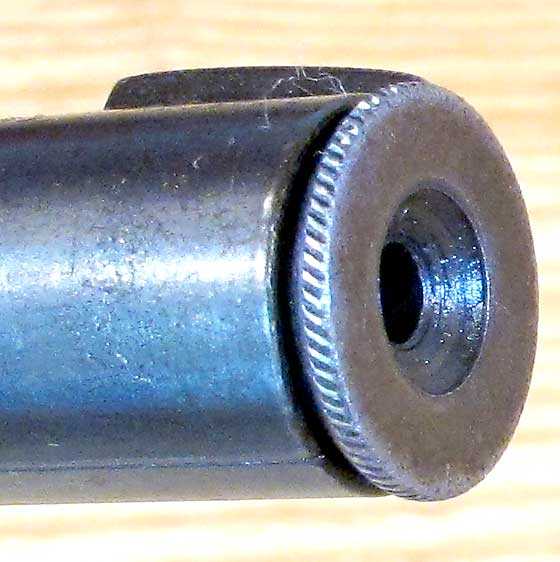
The muzzle is funnel-shaped to expedite loading.
The thing is — it works. Or, at least dropping a BB down the muzzle works. There is no magnet in the breech. You’d need a lead magnet anyway, since this gun is caliber .175 instead of the caliber .173 of a gun made to shoot steel BBs. The shot tube does not taper near the breech to hold the BB tight, so I have no idea how Daisy did this, but it does work. After loading, I held the muzzle straight down and shook the gun. The BB stayed put. [Aside — NOW can you see my frustration when a manufacturer labels their BB gun as .177 caliber/4.5mm? It might not matter to those who buy from discount stores, but in my world it makes a big difference.]
The BB changed from lead to steel
In the late 1920s the BB changed from lead to steel and got smaller by two thousandths of an inch. Read about the history of the BB in this report, How BBs are made. This was also the time when the BB gun changed from shooting lead Air Rifle Shot (sized 0.175-inches) to steel shot (sized 0.171 to 0.173-inches), and that forced some changes in the guns. Today’s gun is an old school gun that was made for lead shot. That fact is even confirmed in the Blue Book of Airguns. I therefore want to use the right ammunition for this test.
Getting 0.175-inch lead shot
I went through this same thing very recently when I discovered that, according to Benjamin, the Benjamin 700 uses 0.175-inch steel Air Rifle Shot. Well, I found a full tin of vintage Benjamin steel Air Rifle Shot and it measures between 0.171 and 0.173-inches in diameter. It has two flats on opposite sides of each BB that were put there during the forming process, so the Benjamin catalog is incorrect. Benjamin steel Air Rifle Shot is not 0.175 like they claim! This clears up a lot and allows me to continue to test the Benjamin 700 as well as this one.
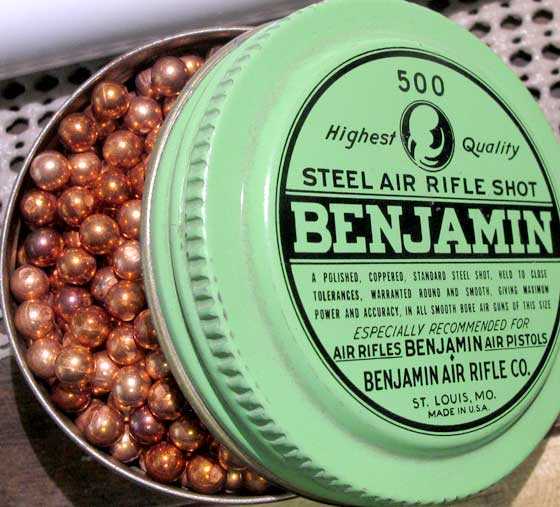
They talk a good game on their tin, but each BB inside has two pronounced flat spots. You can see a couple of them here.
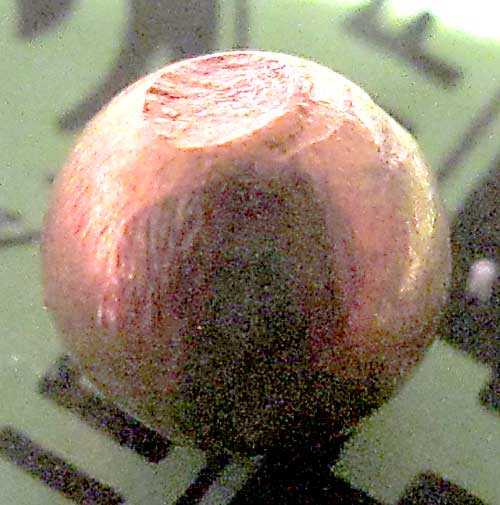
Pardon me for using a handheld macro shot that had to be enhanced a lot. While setting up this photo I dropped this shot on the hard floor. It rolled a few inches then stopped on the flat spot opposite the one seen here. Every BB in the tin has two of these flats. At least they were consistent.
I know that 0.175/4.45mm lead shot is available on Ebay. I bought 1000 rounds, and will use it to test both this gun and the Benjamin. That way I can save my vintage Remington lead Air Rifle Shot. This will probably be a lifetime quantity for me, but I want to always shoot these oldies with the right stuff.
Darts, too!
The removable barrel lets you load darts into the breech. I haven’t been able to locate my .177 darts to know if they fit the bore of the shot tube, but if not I will make some darts of my own to try.
Summary
I began this report by saying I like this gun for its looks. This is one BB gun whose accuracy doesn’t matter, though it would be better if it is. This one takes me back to days before I was born, to think of the little boy who might have once owned it.

B.B.,
I don’t suppose you can run the both the Remington lead Air Rifle Shot and the Benjamin steel Air Rifle Shot the BB Pelletgage? That would help in illustrating the size difference between the shot available then and the BBs being used now. We can then refer to your measurements from the previous report: /blog/2015/12/the-bb-gage-part-2/ for the sizes of the current production BBs.
Siraniko
Siraniko,
I can report the size of the BBs.
B.B.
G’day BB
Hyperdermic disposable needles make good darts. Use guillotine nail cutters on the plastic hub for right diameter and a bit of cotton wool in the needle hub as a better seal. 18G needles good in my blow gun.
Cheers Bob
Bob,
My needles are 32 gauge and a little too small for this, but sewing needles also work well.
B.B.
We used to use stick pins with spit wads in straws in class.
RR
Don’t get me started. 😉
RR,
In my day and area we used BIC pen shafts (the clear, hard plastic ones). It involved disassembly, but it shot true! :^)
Michael
Michael,
We did also. If you were quick you could get it back together before being spotted.
We also used tacks through gum wrappers stuck in the end of straws for darts.
RR,
Years ago, working construction, we would take drywall screws and put them into those conical paper water cups. We would cut off the cup, leaving just enough to fill the inside of a piece of electrical conduit. A 2 1/2′ to 4′ piece of conduit would really shoot those screws — made a great blowgun.
Jim M.
Jim,
You are a twisted genius! I must say, and no offense meant, I’m glad you’re not a kid in my neighborhood!
My Kudos,
Michael
Michael —
Ha! Thanks. No offense taken. I really can’t take credit for that drywall screw idea, although I do believe I greatly improved the technique. I had owned a real blowgun for many years by that time, so was well practiced.
Jim M.
Jim,
That sounds awesome! It is a good thing I didn’t think of that.
B.B.,
Excellent tip.
I wonder how expensive or inexpensive leather craft needles are. I have thought it would be a fun project to fashion some plinking darts for my Cap-Chur. It came into my hands with a factory target practice one, but I would like to preserve that.
Michael
Michael,
The great thing about sewing needles is they come in various sizes.
B.B.
B.B.,
They do, indeed!
Looking at the different of purpose-designs of sewing needles, I had assumed that leather or canvas needles were the way to go, but I just did a small bit of research and have decided that the right needles for my purpose would be the largest size of, believe it or not, Chenille needle. They are thick and have a durable ball point, perfect, I hope, for repeated foam target use and maybe even aluminum cans with a solid foam backing.
Michael
Michael,
You may or may not remember,.. but a few years back I played with shooting arrows and also played with darts. Both homemade mostly,.. for sure the darts. The thing that will become obvious VERY quickly is that if you exceed the weight of the original projectile,… performance will suffer severely.
Than there is the whole fore and aft balance issue as well as center of weight and how much (what %) of the weight is forwards of the length center. And more.
I learned a lot. Arrow building sites are the most helpful on the ratio and math stuff,… which is really pretty basic. A grain scale is a must.
Chris
Chris, Palmer Cap-Chur pistols and rifles are/were Crosman 150 and 160 models converted to .50 caliber. I would guess the one practice dart I have is about 50 grains or so. It’s made of dowel rod plastic fins and a metal point. Made by Crosman or Palmer Industries, but which I don’t know. They were made to shoot veterinary syringes.
Michael
Michael,
The Blue Book has 2 shown. The standard and the VEWT 4X model. Shown with the tranquilizer darts. Thank you.
Chris,
I have a Red’s Special with adjustable trigger and a Standard Capchur pistol. The darts pictured are actual syringe darts. I have just a dart sold to practice with. Palmer made these from modified Crosman 150 pistols and 160 rifles.
I chronied a 225 grain bullet I shot out of my pistol at 180 fps (16 fpe). I imagine the rifle would be about 230 fps, or 26 fpe. 26 fpe would be pretty darned good for a CO2 air gun! Alas, it is a leaker, so I need to address that.
Michael
Michael
B.B.,
A very interesting piece indeed. That lever looks to be quite beefy. All of that bb size stuff gets confusing. Bottom line there is know what you got and what it was made to shoot if getting a hold of a vintage bb gun.
Darts ehh? I almost hope that you do (not) find them, so as that we might be treated to a dart making tutorial! 😉
Good Day to you and to all,….. Chris
BB,
I CAN see a bunch of boys running around with their mouths full of lead shot, spitting down the muzzles of these things. Of course those would have been the “rich” kids. The rest would have slingshots or gravel shooters as they were sometimes called. They would wander down to the pond and shoot the frogs or sometimes a “war” would break out and they would run around and shoot each other. That is when the moms would take them away. Soon all would be reduced to gravel shooters because they were easy to make.
RR
And now you bring up slingshots. We always had our Wrist Rockets folded up in our back pockets as a kid.
My dad worked by a steel mill. He use to bring us home 5 gallon buckets of slag that fell off the train cars as they went by his shop he worked at.. They was round and about the size of a marble. Not perfect round but we could still hit birds or rabbit and such with very little problem out to 30 yards. Man that was fun stuff when we was kids.
GF1,
Wrist Rockets! We always made ours. I didn’t get a store bought slingshot until I was 18.
B.B.,
That’s very interesting about the loading process!
I love these interesting little historical tidbits you throw in;
they really add a lot to the report. =D
Wishing a blessed day to all,
dave
B.B.,
I’ve seen that lever design in photos, but never in person (gotta get to air gun show).
You sure are right about the hard cocking early Daisys. My 1941 Red Ryder with the cast iron lever, really needs the lever to be iron! It is by far the hardest-cocking spring BB gun I have ever shot. How did small kids manage?
Michael
Michael,
It was hard for them. I remember the older short-throw Number 25 pump guns were very hard to cock. Daisy had to change the lever throw (they made the lever parts longer) to make it possible for kids.
B.B.
B.B.,
That makes sense. “Give me a long enough lever, and I can move the world.”
Michael
B.B.,
I ran around for years with a mouth full of pellets. Don’t know why, maybe all my pockets had holes.
Don
B.B.
We also put lead pellets in our mouths. Also, with steel bbs, our mouths were speed loaders for our daisy bb guns. You can spit a mouth full in the little loading gate/hole very quick. Yuk.
Doc
This is a good read for all the “Newbies” to PCP and moisture. After reading this, I too wonder how many PCP’s will be failing in 3 to 5 years.
https://hardairmagazine.com/reviews/warning-distressing-content-pcp-airgun-corrosion-this-is-what-moisture-does-to-your-air-rifle/
Doc
Doc,
Good info. I do not have one other than 60′ of tubing and a 5 micron LP filter. I tore the M-rod down awhile back and 0% anything,.. not that it can’t happen. And the Maximus. I have from a good source that the supplier of the Diablo filter is in a bit of trouble. One seller can no longer get them due to maker/vendor issues. There is other brands. I will be looking at getting something. I like the beads that you can dry yourself the best.
Chris
B.B.,
Off-subject, but I stumbled upon an auction on one of your favorite auction sites for an airgun pellet-shooting indoor training device that retro-fits into a powder-burning semiauto pistol and propels the pellet using percussion caps of a specialized kind (supplied in the kit). The kit has a .177 or .22 air gun barrel that threads into the firearm barrel, and an air gun action that fits inside the firearm action.
The kit seems complete and might even be unopened.
Michael
MPS is the brand name.
Michael
Michael,
Good eye! I just bought something related for the blog, so I’m going to pass on this one.
B.B.
B.B.,
It reminded me your report on the Hammerli K31 trainer. This seems far less sophisticated than that, although that seemed more sophisticated than, well, more sophisticated than just about anything. :^)
Isn’t it wild how in a short period of time an rapid design innovation, or if not outright innovation, at least market-driven dynamics, such as realistically functioning blowback air pistols such as the S&W M&P40, have resulted in legitimate trainers for as demanding an application as law enforcement. From a drop out mag of substantial weight to slide locks, field stripping, working safeties in the position of the real-steel ones, weight, balance, dimensions, contours, trigger type.
If I were an air gun maker executive, I would press for every single semiauto in a particular point bracket to fill all of those criteria. (Obviously, sub-$130 MSRP models could not meet those criteria.)
Michael
Oops. Sorry for my bad form. Here’s the link: /blog/2016/04/hammerli-trainer-part-5/
Michael
B.B.,
I got thinking. Whatever that “something related” is, I can’t wait! :^) You are very adept at the tease, B.B. Please do not take that as a criticism. I mean it as a high compliment.
Training devices that incorporate air gun technology are fascinating to me, going back, probably, to your reporting on instinct shooting with Daisy BB guns long ago (quick-kill/quick skill, etc.).
Michael
Michael,
This one will be so novel I will have everyone asking for more! It’s weird enough that I had never heard of it.
B.B.
B.B.,
As always, I am looking forward to the “rest of the story” on this one.
Off topic — Do you have the Weihrauch HW 44 on your list to test? If not, would you consider adding it?
Have a great week.
Jim M.
JimM,
I will consider it if enough people want to see it. A thousand-dollar air pistol has to do a lot to sell.
B.B.
B.B.,
In your opinion,…. is it worth doing head (and) weigh sorting VS just head sorting based on your experience?
Sure,… doing both eliminates 2 variables, but is it worth it? From what I have learned here,… head sorting is # priority if you are going to do any sorting at all.
Chris
#1,…. Ooops! 🙁
Chris,
Do we need to design a test?
B.B.
B.B.,
I am not sure what you mean to be honest. I figured that you have (or know people that have) that that have done one, or both,… and even? more.
Trust me, I will do head,.. and depending on the results,… weigh also. I have already done both with the M-rod. With the M-rod,… I got results,… but not repeatable (for whatever reason) over a period of several test.
But yes,… it would be a good “design test”,… if that is what you meant. You were talking (fit to bore) there awhile back,… which I suppose IS what we are talking about.
Sorting IS a bit of work. Head sorting is not bad with the Pelletgage,… but weigh sorting is a bit more tedious. My scale goes to .1, which I think is more than good enough.
So,.. whatever you think. I do think that it would help people’s groups in general if they at least did head sort. As you FOR SURE know though,… everything else needs to be “in order” to have a controlled test. You have the know-how for that. Someone on a fold out card table, wobbling around on 16 mag. will never know.
As Geo said,… maybe I am finally down to “splitting hairs”? If so, great. But really I was just asking for your gut feeling based on your experience and what you have seen from others. If you are up for a nice testing,…. then bring it on!,…. by all means! 😉
Thanks,…. Chris
B.B.,
Were you thinking of doing something for the blog? Or, were you referring to designing a test for me? You left me hanging a bit there with your question.
If you have not yet done one on sorting head and weight and any realized benefits,…. then yes,.. I think it would very good. I know that in the past you have done bits and pieces in various blogs,… especially if you are having unexplained inconsistency issues.
As for me, I will be very scientific and “anal” 🙂 as usual,… and report back here to all, as testing progresses.
Something from you would be nice though. I wonder what gun you would choose,… if you were to do one?
Chris
Chris
Chris,
I don’t mind doing the test. What I wanted was some discussion about what should be tested and how. I don’t want to test one way and get the peanut gallery after me when I publish it.
B.B.
B.B.,
Well,.. I would defer to you as to how to (do it best). I was hoping that this topic has come up enough in your own personal circle of airgun associates and they have expressed there opinions. Plus,.. any of your own. You used to shoot pistol competition and figured that maybe you have given some head and weight sorting a try in your own past.
As for any ideas,… a very good rest and a very good gun. Cost of gun would not be so much of an issue,… but rather is it accurate enough that it would pick up on small weight and head inconsistencies. 24x + on the scope. 25 yards, at least. If results are too close,.. push it out. A PCP would be my choice. You are a very refined and well respected shooter, so that variable is locked in. Crystal clear sight and rock solid rest. That is about it.
It could be too that a $300 PCP would show very good improvement and also a 2k one. The 2k one might do tighter groups, but I would think that both would show improvement.
I will give it further thought and in the mean time be doing my own testing. Initial testing will be just sorted and un-sorted. I will re-fine from there. As you know, the extent to which it can be taken is near limitless.
As for the “peanut gallery”,… well,…. you are ON the playing field and “they” are in the grandstands/peanut gallery. A true player. It would not be the first time that you have broken a conventional mold,.. ehh? 😉
I am getting a strong sense that you have not,.. but would very much like to do,.. such an extensive test. I may be off base on that?
Chris
Chris,
I would like to do the test, as long as we all agree what the test is.
For example, you mentioned using a PCP, which I agree with. How many shots per group? How many groups per test? Test the heads and weights, then just the heads, then just the weights then random pellets, or do we purposely introduce heads and weights that are not the same?
That’s what I’m talking about.
B.B.
B.B.,
I do see and I have tried about everything you said at one point or another.
Shot per group poses an issue if putting 10 into 1/2″ at 25 yards. You may see how the first 5 landed, but the next 5 will just be going through open air/paper. Pushing out further may help.
1 shot per bull/dot is an option, but not easy to come up with a group size.
Introducing (known) rouges is a must. I say “known”, because the pellet was weighed and head sorted, but was at some extreme from the test pellets.
As for a gun, perhaps something like the AA 510 Ult. Sptr. FAC. You know, the top of the line 510. That is a common one, good quality and something that PA would have. I would do .22. One, you have pellet choice and two, it will carry better if shooting at 25-50.
5 per bull, note landing per pellet? If it is too accurate,.. push the target out.
In my past, for whatever reason, I have not had something that was that accurate (and) solidly rested (and) high magnification. (You Know) what I am talking about. Get that mix right and it is like you can’t miss. If you do, your confidence level is pretty high that it was the pellet.
It is a work day and time is short, but looking forwards to more of your thoughts. Plus, I have 15 min. to read todays article! 🙁
Chris
B.B.,
What about ((single)) shots into a #’d score ring/target? You have experience with scoring. You may have to see what the gun is capable of and then custom size it. That way you could do 10 shots with a “batch”, which is statistically the best, and not have them land on top of one another. 10 single shots into the 9 ring (10 bulls) equals a 1/2″, 10 shot group,… for example. That way you could produce a group size as well. Just another idea.
Chris
B.B.,
Another interesting idea is that sorted pellets will produce more accurate groups,.. but,… one batch may land a bit different from the other batch. One (matched) batch = on bull,.. while the other matched batch lands 1/4″ higher and 1/4″ left,… but,… both groups are the same size. Accuracy both ways,.. but the head and/or weight made the difference in the POI. Just a thought.
Chris
Chris
I have not found enough accuracy variation correlating to pellet weight to justify doing it. However 25 yards is my maximum shooting distance with airguns. As for measuring head diameter, I do less than I used to do because I buy those match pellets that are more uniform. The Pelletgage showed me which ones to buy along with accuracy performance.
Decksniper
Decksniper,
Good pellets do make a difference. I have found the heads on good pellets to be within 1 of 2 hole sizes on the Pelletgage for the most part. The weights on the other hand can vary considerably. Question is: How much does .1 grain in weight difference factor in? Or does it take 1 grain? Or 2? .5 would be my gut.
Chris
Chris
I’m only guessing that longer ranges would be more apt to come into play than close in shooting for inaccuracy due to weight variation in pellets. I hope someone will comment who does 40-50 yard target shooting. Gunfun1? Others?
Decksniper
Okay, I am one of the “newbies” to PCP airguns that Doc Holiday mentioned above. I am using a HPA hand pump to fill my Gamo Urban. I try not to fill it too rapidly to reduce generated heat. When I open the bleed screw no moisture is ever present. Can I assume that moisture is not entering the pressure tube? It seems like B.B. posted something about not using a filter with a hand pump and there were no issues from moisture. So guys, should we be using a moisture filter in all cases? There seems to be some differences of opinion on this. PCPs are expensive and we certainly want to take every precaution to prevent damage.
Geo,
Spot on comment. I have yet to see an issue,.. even with a tear down,… but you did see the article. Better to have, than to not have, I think is the bottom line. Climate and humidity I think would be HUGE factors. I will be looking further into getting something though. I only pump indoors which is heated or cooled. Better, but maybe not the most ideal. It is 71 degrees now in the house and 53% humidity,… which is very comfortable. In Ohio, it is rare to see below 25% inside. Outside can easily go to 99%.
Chris
Okay GEO 791,
NO TOP BUTTON solutions today!
All kidding aside corrosion is obviously not something we want in any weapon…but did anyone else notice what the For Sale item was in the piece? The moisture actually condenses based on the Dew Point (DP) temperature not based on relative humidity. When the air temperature in the storage cylinder and the Dew Point temperature are the same water condenses out of the air (it could also be cold outside and the metal/material of the cylinder cools enough toward the DP that it condenses on the inside wall/regulator/valve/barrel or that puff of cloud past the muzzle! Is it a really problem (all caps to show the breatless nature of the piece referenced) THAT WILL EFFECT ALMOST ALL PCPs IN THE NEXT THREE TO FIVE YEARS…I doubt it! Other far more experienced and known writers, airgunsmiths, and posters have the same opinion. My thought is how well do folks clean off their salty fingerprints before the assemble/reassemble a HPA/PCP pressure vessel and it’s component parts? Notice how adding a bit of chamber oil to the filler nipple/fitting to be blown into the pressure vessel is recommended by folk we know and trust. Dry air is good but most of the user systems just don’t remove ENOUGH water vapor to make a big difference. Commercial Dry Air from dive shops is not 100% dry!
So what’s to be done? Chamber oil in very small quantities and inspection by a qualified airgunsmiths or a skilled PCP user seems like the best option.
How can I say that? I have had high pressure PCPs for over 20 years and none have any corrosion. I can not believe that it was simple water that caused the corrosion shown in those or other photos I have seen of pressure vessel corrosion.
Also, I have seen beautiful blued metal, stainless steel or Parkerized guns be touched by The Unholy Salt Touch and rust in hours. Also naked and highly polished brass fittings on the Quarter Deck or polished aluminum aircraft skins tarnish in hours after these EVIL creatures have lightly touched them.
Argh!
shootski
shootski
Shootski,
Thank you very much for your empirical experience with PCPs and moisture issues. I fill my PCP in my basement where I run a dehumidifier and keep the humidity at about 60%. That just happens to be where my shooting stuff is kept so I just take my Urban downstairs to fill it. Like I said, I’ve never seen any moisture escape from the bleed screw, so I didn’t think moisture was a problem.
Regarding rusty finger prints, it’s strange that some people can touch the metal on a rifle and it’ll leave a rusty print in a short time. Then again, others don’t seem to have that effect. I don’t seem to have the problem but I still always rub the metal down with a gun cloth and Balistol. I have always heard that when a women is going through her period, her finger prints will rust the metal very quickly. That may be an old wives tale but I wouldn’t take a chance on it. If anyone touches any of my guns I wipe them down with Balistol before I put them away.
I recently noticed that the Diana RWS 34P that I sent to B.B. for testing had a small spec of rust showing right at the edge of where the breech meets the stock. As soon as I noticed it I removed the stock and cleaned the spot with Balistol and 0000 steel wool. There was no rust underneath when I removed the stock to check. I was surprised to see the rust spot as I am sure B.B. carefully wiped the metal down when he had it.
Thanks for weighing in on this subject.
GEO791,
You, and anyone else, may want to get some STAINLESS steel wool in various grits for removing rust blush from ferous metal parts. Same thing is true for BRONZE and BRASS metal but copper wool or a softer bronze or brass wool works for those metals. The problem with plain steel wool is that tiny particles can dust off it and contaminate with rust the ferous metal they stick too.
I have also read in a metal care article some years ago that once rust/corrosion gets a foothold it will spread much like cancer does especially in cylinders and pipes. So inspection of parts when they are disassembled and anti corrosion handling and treatment before reasembly is going to help preserve your PCPs more surely than desicants and drying systems.
That’s my opinion based on 20 plus years experience with PCPs and dive cylinders.
IF I get better information I will apply it and share it far and wide.
shootski
Thank you for that information. I’ll try to find some stainless steel wool. Can’t say that I have ever seen any though.
Hey Everybody I am posting my entire collection of Daisy bb guns on https://pickingadaisy.com Is there anyone else here that collect Daisys and post them online for us all to gawk at? Thanks to Tom and everyone at Pyramyd for being such an amazing resource for us all!
CaliAir,
Welcome to the blog.
B.B.